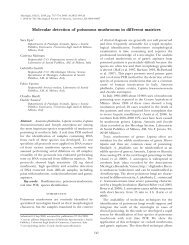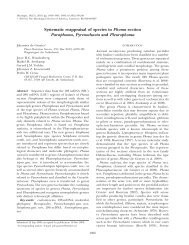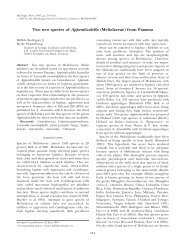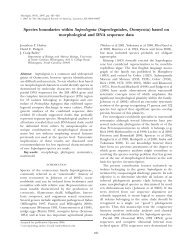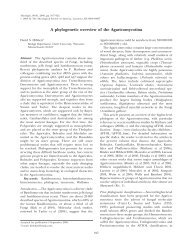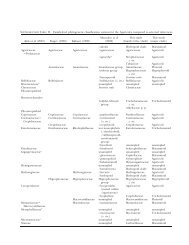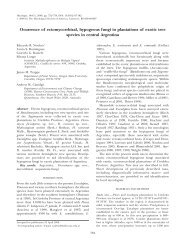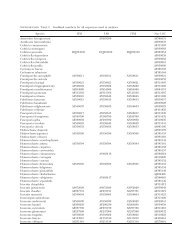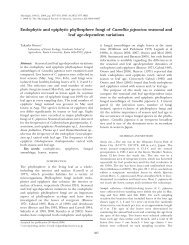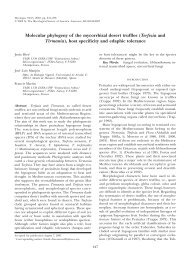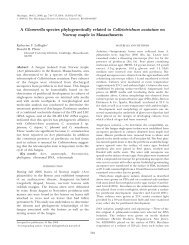Short title: Revision of Morchella taxonomy Taxonomic ... - Mycologia
Short title: Revision of Morchella taxonomy Taxonomic ... - Mycologia
Short title: Revision of Morchella taxonomy Taxonomic ... - Mycologia
Create successful ePaper yourself
Turn your PDF publications into a flip-book with our unique Google optimized e-Paper software.
subglobose but occasionally clavate or merely cylindrical with a rounded apex.<br />
Ecology. Appearing at approximately 1200 m in lightly burned spruce and fir forests.<br />
Found in the year following summer forest fires; August. Specimens examined<br />
(SUPPLEMENTARY TABLE I) were collected in Oregon.<br />
Comments. <strong>Morchella</strong> capitata corresponds to phylogenetic species Mel-9 in O'Donnell<br />
et al. (2011). Among the confusingly similar burn-site morels in western North America,<br />
<strong>Morchella</strong> capitata is distinct microscopically, based on the specimens examined; elements on<br />
its sterile ridges are overwhelmingly capitate, <strong>of</strong>ten dramatically so (SUPPLEMENTARY FIG. 4).<br />
Specimens we studied <strong>of</strong> M. sextelata and M. septimelata, which are nearly identical to M.<br />
capitata in macroscopic features and which also occur in conifer burn sites, had sterile ridge<br />
elements from cylindrical with a rounded apex to subclavate, subfusiform or subcapitate.<br />
Because several <strong>of</strong> the collections studied (08070401, 08070408) had greenish pits, M. capitata<br />
probably has been included in commercial collectors' concept <strong>of</strong> the "pickle" and in the concept<br />
<strong>of</strong> the "green morel" set forth in Pilz et al. (2004, 2007); however, several M. sextelata and M.<br />
septimelata specimens also had greenish pits. <strong>Morchella</strong> capitata was treated in Kuo (2005) as<br />
one <strong>of</strong> several "Other North American Black Morels" appearing in burn sites.<br />
<strong>Morchella</strong> importuna M. Kuo, O'Donnell & T.J. Volk, sp. nov. FIG. 15<br />
MycoBank MB 563958<br />
Ascomata 60–200 mm alta; capitulum conicum vel ovatum; costae aequabiles, perpendicules, atrae, similes scalae;<br />
hymenium fulvum; biotopium in hortis et terra perturbata; sporae 18–24 × 10–13 μm. Holotypus: Biotopium in<br />
horto; USA, in Washingtonense, ad King County; A. Thrailkill col.; specimen typicum in Herb. F (04130401)<br />
conservatum.<br />
Etymology. The epithet means "assertive" or "inconsiderate" in character; the species<br />
<strong>of</strong>ten is the cause <strong>of</strong> consternation and distress among gardeners and homeowners whose



